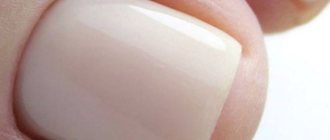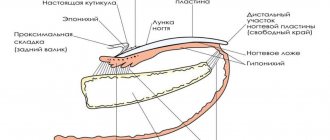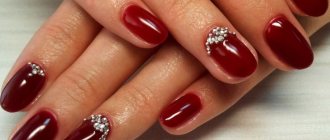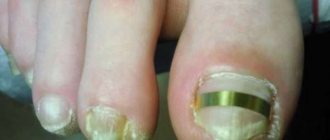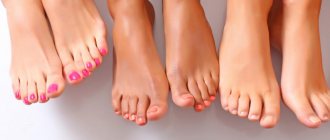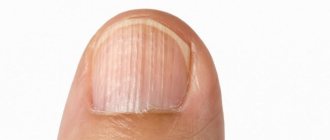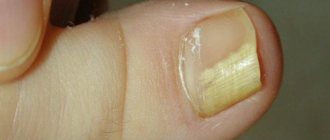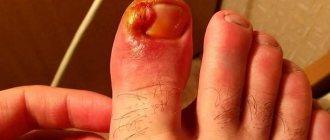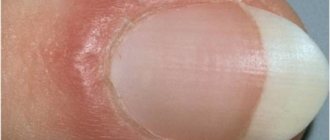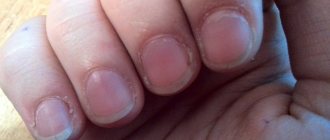Causes
In 60% of cases, onycholysis develops after a blow, from injury, or when a nail is pinched. Moreover, even a minor injury is enough that a person will not pay attention to. The second most common cause of nail onycholysis is fungal infection (onychomycosis). The disease is also caused by allergies. For example, when hands come into contact with household chemicals.
Depending on the cause, the nail may be affected only on one finger or on several fingers at the same time.
The risk group includes people who have:
- chronic skin diseases (eczema, psoriasis);
- malnutrition, deficiency of vitamins A, E, group B;
- metabolic disorders;
- predisposition to allergic reactions;
- weakened immunity, including during pregnancy and old age;
- diabetes.
The disease onycholysis often appears in workers in the chemical industry and laboratories, whose hands are constantly in contact with organic solvents and aggressive substances.
Due to the desire for beauty, women face this problem more often than men.
Onycholysis is caused by:
- nail extensions;
- improper performance of manicure or pedicure;
- injury to the cuticle area;
- the use of decorative varnishes, liquids for their removal containing harmful organic solvents;
- gel polish coating.
Almost all women like to do the procedures listed above to make their hands look attractive and well-groomed. But the first thing to remember is safety. Because many of them do not have the most favorable effect on nails. Cause allergic reactions, chemical burns, burns from an ultraviolet lamp.
Often onycholysis occurs on the hands from gel polish or shellac. Why is this happening? The reason is ignoring precautions. When drying under a UV lamp, the nail burns. Therefore, if the master says, take it out, if he bakes, you need to do it. If you tolerate the burning sensation for a couple of minutes, the consequences can be dire. You risk being left not only without a manicure, but also without nails. The burning sensation provokes a burn, a disruption of the connection between the plate and the nail bed. Therefore, you need to take your hands out from under the lamp for a few seconds until the discomfort disappears.
An effective way to restore the nail matrix | Beautiful nails
Damage to the matrix is a rather serious pathology, which can be caused by mechanical trauma or various types of bacterial or fungal infections, so it is strictly not recommended to overlook it.
And most often, damage to the nail matrix is provoked by various types of injuries, among which, first of all, is an incorrect manicure. The fact is that cutting the cuticle too deeply with a special slingshot and any other manicure tools often leads to injury to the matrix hidden under the lower periungual ridge (the nail root responsible for the growth of the plate, which is hidden under the skin), and how to restore the nail matrix later for most unskilled craftsmen remain unknown.
Meanwhile, constant improper trimming of the cuticles, which affects the deep layers of the nail plate, often leads to the nails gradually thinning, becoming bumpy, and in some cases stopping their growth altogether due to severe damage to their matrix part. And if you continue to act in the same spirit, you can get even more serious problems, because the restoration of the matrix is a very long process, which, moreover, does not always give a positive result or at least some changes in this direction.
Therefore, the first thing to do on the path to recovery is to stop injuring the nail bed, and with it the root part of the nail plate, forgetting about manicure for a while or performing it in an extremely gentle manner. Naturally, these measures alone will not be enough, especially if the matrix has been severely injured, so experts strongly recommend using a vitamin-mineral complex in the form of oil or ointment, which should be applied daily to the affected area. The same picture can be observed if the nail plate was injured as a result of pinching, impact with a heavy object, or a cut. As for the recovery time, they directly depend on the degree of damage to the root part of the nail and, if in one case everything can take several months, in another the rehabilitation process is delayed for years, despite the fact that the nail does not take on its previous shape in all cases. cases.
Daily baths with iodine and sea salt or a long trip to the sea will help enhance the effect, because nothing promotes nail growth like pure salt water. In some cases, the patient is prescribed baths with the addition of essential oils, some types of which stimulate blood circulation and significantly improve the nutrition of the nail plate, thereby promoting its growth. The pepper mask, which is prepared from a gruel of red hot pepper and moisturizing hand cream, has also proven itself quite well, although it can only be used if there are no open wounds or cuts on the fingers. The fact is that chili pepper has a number of vitamins that stimulate nail growth and strengthen the new plate.
However, this, like many other methods, is absolutely ineffective if the nail matrix has been removed. Thus, partial or complete resection of this part of the plate is carried out when it has pathologically grown into the periungual ridges or is affected by a fungal infection that has spread over the entire surface of the nail, including its root part.
A similar situation often occurs when the plate is detached due to the formation of a subungual hematoma. In this case, it will be impossible to restore the nail matrix, since in essence there will be nothing to restore and these consequences must be taken into account when carrying out such a radical surgical intervention.
Kinds
Depending on the cause, there are several types of disease.
The most common onycholysis is:
- Traumatic. Nails begin to peel off after blows, wounds, burns, splinters, exposure to heat, cold, prolonged exposure to water, or wearing tight shoes. This also includes pathological changes caused by the action of acids, alkalis, solvents, and household chemicals;
- Fungal. It occurs due to the entry and reproduction of fungal infection pathogens in the subungual space. Formed as a secondary complication of onychomycosis;
- Allergic. Onycholysis develops as an allergic reaction due to taking medications with photosensitizing properties, ultraviolet irradiation (photo onycholysis), and contact of the nail plate with harmful chemicals.
Depending on the size of the affected area, onycholysis can be partial, when only a small area of the nail peels off in the form of a strip or semicircle, and complete, when it comes off entirely. Separation of the nail plate can occur from the distal (free) edge or from the lateral ridges (lateral onycholysis).
How to recognize the disease?
With onycholysis, voids form under the fingernail, caused by its inability to grow to the nail bed and air entering the resulting cavity. The main symptom is a change in the color of the nail plate. It becomes cloudy, whitish-gray. In this case, the detachment border most often has uneven edges. Similar symptoms are observed on the legs.
With an infectious cause of the disease, the nail additionally changes its structure, its surface becomes rough, and the color is yellow, brown or green.
With onycholysis, the nail does not grow and becomes brittle and brittle. If an infection gets into the subungual space, a person feels discomfort, pain, and suppuration.
Nail plate injury | Newspaper I
A torn nail - sometimes down to the meat - is still a problem. What to do? Of course, the answer is obvious: go to a specialist. He knows exactly what to do. Surgeons have a lot of experience in dealing with not such injuries. But it’s not always possible to get to a doctor right away. Therefore, act without panic.
Assess the scale of the “catastrophe”
First, determine how damaged the nail plate is. If the nail remains in place and is not completely torn off, but there is a crack, it will be easier to help yourself. Although sometimes blood and pus may accumulate under the remaining part of the plate.
But usually nothing serious happens, but it also happens that the nail breaks and in some part is torn off from the skin. Of course, the blood is gushing, and the pain is almost unbearable, but don’t worry: the pain will quickly pass, and the nail will grow back if it is treated correctly.
The first step is to remove all jewelry from the injured arm or leg. The limb should be raised and held above the level of the heart - this will help reduce blood flow to the nail.
Proceed in order
Do not tear off the torn nail plate. Trim it from time to time so that the nail is as short as possible until it grows completely.
Now you need to clean the wound. Pour hot water into the basin. Finely chop a piece of laundry soap, throw it into the water and stir until the soap is completely dissolved. When the soap and water has cooled down and is slightly warm, dip your foot or hand with a damaged nail in it and hold for about 30 minutes.
Disinfection is carried out at least once a day until the wound is completely healed - about a week. Laundry soap disinfects and speeds up the healing of torn nails.
Fingernails grow at a rate of about 4 mm per month. Toenails grow more slowly, by about half. It turns out that nails can fully recover within three to six months. But! If the matrix has been damaged, the nail grows more slowly and it will take about three more months for it to fully recover.
Strengthening Tips
After improvements are noticeable and the nail begins to take on a healthy appearance and the wound surface heals, you can begin measures aimed at strengthening the nail plate. The best way is gelatin baths.
To prepare them you will need 1 tablespoon of dry gelatin, which is diluted with a small amount of water. After the product swells, it is sent to a water bath and waited until completely dissolved.
Do not allow the composition to begin to boil during the cooking process - this will lead to a complete loss of all beneficial properties. Once a comfortable temperature is reached, the nails are dipped into the composition for the procedure. The duration of the event is 25-30 minutes.
They must be carried out regularly, at least three times per week.
The duration of the procedures depends on the results, which will be individual in each case. It is better to resort to such measures as often as possible and not stop them until the nail is completely restored. If you follow all the recommendations and do the procedures regularly, then in a month there is a chance that a new healthy nail will grow, and at the same time all the others will become stronger.
Possible complications
If you ignore a nail injury and do not take measures to cure it, there is a risk that the unhealthy condition will become chronic. Even if the new nail structure begins to grow, it will not be able to acquire a normal, healthy state and will always be curved.
If the nail matrix is damaged, the growing nail plate will contain a defect. Minor damage will result in minor defects. And larger defects can lead to permanent deformation of the nail. Damage and scarring of the nail bed can cause white spots to appear on the growing nail.
When to see a doctor
If there are any signs of infection, swelling, pus or increased pain that you notice a few days after the injury, then a visit to the doctor is a must.
If there are tears or torn areas of the nail, a large hematoma (more than 50 percent) or deformation of the finger, you should seek medical help.
Also consult a dermatologist to rule out mycosis and prevent its development. Despite the fact that injury to the nail plate is a very unpleasant situation, you should not panic or get upset.
Therapeutic measures will eliminate wounds and injuries in a short time, and strengthening procedures will help make your nails better.
Prepared by Kristina Marinina based on materials from assol-club.net, ruka.site
Source: https://yagazeta.com/stil-zhizni/travma-nogtevoj-plastiny/
Diagnostics
If you suspect detachment of the nail plate, you should visit a specialist (podiatrist, dermatologist). To confirm the diagnosis and find out the cause of onycholysis, a fungal test is performed.
Based on external signs, it can be confused with onychomycosis, psoriasis, lichen planus and other types of onychodystrophy. Therefore, differential diagnosis is needed. A fungal infection is indicated by a yellow, brown or green color of the nail, its thickening, an unpleasant odor, and itching of the skin around it.
Many who have encountered onycholysis are interested in whether it is contagious? It is not contagious in itself. But often its cause is a fungal infection, which is easily transmitted from one person to another through contact and household contact.
Nail Matrix: Anatomy, Functions, Injuries and Disorders
The nail matrix is the area where fingernails and toenails begin to grow. The matrix creates new skin cells that push out old, dead skin cells to make nails. As a result of injury, but
What is a nail matrix?
The nail matrix is the area where fingernails and toenails begin to grow. The matrix creates new skin cells that push out old, dead skin cells to make nails. As a result, trauma to the nail bed or disorders affecting the matrix can affect nail growth.
Nail anatomy
When it comes to nail anatomy, it's important to consider what you see and what you don't. If you look at the top of the nail, you will see the nail plate. Below the nail plate is the nail bed. The nail bed is where the nail adheres to the finger.
Other key elements of the nail include:
- Lunula. White cells in the shape of a crescent at the base of the nail. Some people can only see the socket on the big toe, while others cannot see it at all.
- Sterile matrix. This is the area of the nail above the hole. The nail usually changes color outside of the germinal matrix (see below) as it extends into the sterile matrix because after this time the cells no longer have nuclei, making the nail more translucent. This area is the next most common site for nail cell production. The skin of the fingertips is connected to a sterile matrix.
- Germinal matrix. This is the area of the nail below the lunula (closest to the joint). It is estimated that 90 percent of nail production comes from the germinal matrix. This gives the nail a natural curvature.
- Edge of the nail bed. Structures surrounding the nail plate.
- Cuticles. The area of skin where the nail grows from the finger. Provides protection to the nail matrix.
Your nails typically grow about 3 to 4 millimeters per month. Some people's nails grow faster, including younger people and people with longer nails.
Injuries and diseases affecting the nail matrix
Nails are designed to protect fingers and also to aid in opening, scraping and tearing. Like other areas of the body, they are susceptible to injury and disease. Below are some conditions that can affect the nail matrix.
injury
An estimated 50 percent of nail injuries are due to a broken finger. Nail trauma can stop the production of new nail cells for up to three weeks.
Nail growth usually resumes at a faster rate and is stable after about 100 days. You may notice that the nail appears thicker than usual.
The extent of the injury often depends on where it occurs. If you have a deep cut or injury to the germinal matrix at the base of the nail, the nail may never grow back.
Ingrown nail
An ingrown toenail occurs when the nail grows into the skin of a finger or toe, usually due to cutting the hair too short. However, nail trauma and tight shoes can also cause ingrown toenails.
Symptoms include a swollen and painful nail. Sometimes the area can become infected and will be red, sore and sore.
Melanonychia
Melanonychia is a condition in which brown pigmented spots appear on the nails. Those with dark skin are more likely to get the disease. This unevenness appears as a vertical brown or black streak up the nail plate.
Melanonychia is a broad descriptive term that can indicate normal nail color variation or something as serious as subungual melanoma (see below). Several conditions and events can cause melanonychia, including:
- bite your nails
- psoriasis
- pregnancy
- Cushing's syndrome
- chemotherapy drugs
- nail infection
Subungual melanoma
Subungual melanoma (or nail matrix melanoma) is a condition in which cancer cells grow in the nail matrix. Cancer cells can cause changes in the pigments in the nails, known as melanin. As a result, a distinct streaky discoloration may grow on the nail matrix.
If you notice changes to your nail that are not explained by injury, talk to your doctor to make sure they are not due to subungual melanoma.
pterygium
Pterygium unguis is a condition that causes scarring that extends into the nail matrix. This causes the nail fold where the nail would normally pass over the tip of the finger to fuse with the nail matrix. The nails on the nail plate take on an uneven appearance.
Lichen planus, burns, and lupus erythematosus cause pterygium.
Nevomelanocytic nevus
A nevomelanocytic nevus is essentially a mole or collection of melanocytes under the nail matrix. It can be present from birth or acquired after a nail injury or as a result of aging.
The problem with nevomelanocytic nevus is that it is difficult to distinguish between a nevus that is not harmful and a color change that indicates cancer.
whitlow
Paronychia is an infection of the fingernails or toenails. This condition can be acute or chronic, which can lead to deformed nails. Symptoms of paronychia include swelling, redness, pain, and pus-filled areas around the nail. Fungus or bacteria can cause paronychia.
Dystrophic onychomycosis
Dystrophic onychomycosis is a fungal infection of the skin that causes complete destruction of the nail plate. The disease usually occurs when a person has had a severe fungal nail infection for some time and has not been treated or not treated completely.
Some common causes of dystrophic onychomycosis include:
- psoriasis
- lichen planus
- contact dermatitis
- injury
Diagnosis of problems
A doctor can diagnose some nail problems by visual inspection and listening to a description of symptoms. This is true for many fungal nail infections with crumbling, itching and redness around the nail.
However, some conditions may require further testing. This involves obtaining a sample of the nail by cutting off part of the end or performing a biopsy of the nail matrix.
Nail matrix biopsy
In a nail matrix biopsy, the doctor takes a sample of the nail matrix to test for the presence of irregular cells, such as cancer. Because the nail matrix is deep at the base of the nail, doctors usually perform this procedure under local anesthesia.
The doctor may strategically inject a local anesthetic into the base of the finger, numbing the finger. When the doctor removes part of the nail matrix, you should not feel pain, only pressure. The biopsy approach depends on which area the doctor is testing.
Takeaway
The nail matrix is responsible for nail growth. It may be vulnerable to damage and disease. Seeing your doctor if you experience any discoloration, pain, swelling or other symptoms can ideally ensure that you receive treatment as quickly as possible.
Source: https://ru.dderamus.com/nail-matrix-11402
Treatment
Treatment of the disease is long-term, taking up to 5–6 months. Selected individually, taking into account the reason. For help, you need to contact a dermatologist, podologist, or mycologist. The larger the area peeled off, the longer the recovery will be.
Treatment for nail onycholysis includes:
- cleaning or removing the exfoliated part of the nail plate;
- fight against fungal infection, if it has been detected;
- protection of the exposed soft tissue area;
- prevention of infectious complications;
- stimulation of nail growth;
- correction of a cosmetic defect.
It is recommended to consult a doctor immediately. The use of folk remedies and methods to treat onycholysis without consultation is fraught with complications. It is very important not to let the problem take its course. The more time is lost, the less likely the nail will grow. When a cavity forms between the nail and the nail bed, the skin becomes hard over time and can no longer adhere to the nail.
The main thing that needs to be done to effectively treat nail onycholysis is to stop the influence of the traumatic factor. If the detachment occurs due to an allergy to washing powder or cleaning agent, you need to change them to others and use thick rubber gloves.
If the cause is infection, measures are necessary to destroy the pathogen. To combat the fungus, varnishes, local ointments, and creams are used. In severe cases, antifungal drugs are added orally. The course of treatment and specific medications are prescribed by the doctor. For bacterial infections, antibiotic ointments are prescribed.
If detachment of the nail plate occurs due to a nail injury, prosthetics with a special medical gel are used to correct the cosmetic defect. It differs from standard gels that are used for extensions. Made from hypoallergenic components, does not cause an allergic reaction or burn. Gel prosthetics for onycholysis helps to close soft tissues, minimize the risk of injury to the nail bed, and prevent infection. Materials for prosthetics contain antifungal and antiseptic additives. But this method can only be used in the absence of infection.
To speed up nail growth, vitamins, iron and calcium supplements are prescribed. Local remedies (oils, cuticle creams) and finger massage are also used to improve blood circulation.
Onychotillomania (destruction of one's nails): causes, treatment and other aspects
My daughter (22 years old) has terrible ugly nails, both big toenails. As if disfigured with holes and bulges, especially one. This is a very long time ago, since childhood. Although there were no injuries. But she has a bad habit, she picks at them. We even tried to reduce it with a product, but the terrible nail grew again. Which doctor should we contact?
Olga
Answer
Olga, hello.
Your daughter has onychotillomania, a type of dermatomania in which the patient tries to destroy his own nails. By nature, this condition is close to onychophagia (the tendency to bite the nail plates), with the difference that with onychotillomania, the matrix of the nail plate is more often damaged.
If the matrix is damaged, the growth zones are destroyed, which leads to visible deformation of the plate. It is not a fungus, not psoriasis, not contagious, but difficult to treat. If the daughter does not stop picking her nails, the nail plate will not be able to recover. Given the anamnesis, matrix regeneration may not occur at all.
Reasons for the development of onychotillomania
Obsessive-compulsive disorder (clean hands disease)
In psychiatry, it is believed that onychotillomania is a symptom of paranoid states and neuroses.
Paranoid people often injure their nails, cleaning them from germs (obsessive states). This manifests itself in the form of scratching, piercing, and constant washing of the nail plate.
In mentally healthy people, onychotillomania can be used as an attempt to avoid solving a complex psychological problem.
The problem itself may not be recognized by the patient.
Considering the girl’s age, it is worth referring her to a psychotherapist/psychiatrist to identify the reasons for this behavior.
Clinical picture
Nail plate with onychotillomania
In the vast majority of cases, the nails of the thumbs are affected.
Knives, screwdrivers, razors, and your own fingers can be used for destruction. The longer the nail is destroyed, the worse the nail plate looks.
If the matrix is accidentally damaged in a beauty salon, one longitudinal strip appears, the so-called. trachyonychia. In your case, the matrix is much more damaged, which determines the appearance of the surface (depressions, delamination, etc.).
Damaged nails often grow back. Hemorrhages under the nail plate may be observed.
Treatment of onychotilomania
The profile specialist is a psychiatrist, neurologist or experienced psychotherapist.
You can simply cover your nails with a plaster
After the cause of stress (external or internal) is localized, sedatives are prescribed to compensate for the condition. The role of the dermatologist in the treatment of onychotilomania is auxiliary. Its task is to prevent the attachment of a fungal or bacterial infection (it is easier for the pathogen to “sit” on the provoked surface).
If we consider the problem from the point of view of psychiatry, then onychotillomania refers to compulsive states and is treated with antidepressants - serotonin reuptake inhibitors (Indalpin, Cytolopram, etc.).
A simple technique that is effective at home is gluing your nails with adhesive tape. For the same purpose, nails can be strengthened with cyanoacrylate glue (strong connection).
An indirect sign of mental illness will be attempts to rip off the band-aid and paint acrylic to get to the nail.
The glue is applied once a week. In successful cases, the matrix is restored, the nail takes on a normal appearance after six months.
There is an allergic reaction to acrylic - if there is redness or itching, the product should be discontinued.
To accelerate the regeneration of the matrix, vitamin A and multivitamins are prescribed
Herbal medicine for compulsive conditions
Herbs can be used as an aid
Herbal treatment is used as an adjuvant. Herbal medicine reduces stress and the desire to damage or bite nails, and stimulates tissue regeneration.
Equal parts of peppermint, rhizomes with valerian roots, hop cones, motherwort herb and rose hips are used.
Pour 250 ml of boiling water into a thermos and leave for 2 hours. After straining and cooling, consume 100 ml 3 times a day (the infusion should be at room temperature).
Herbal tea. Fennel fruits, mint, lemon balm, oregano and chamomile are used. Prepared in the same way, drink warmed.
Nail care
Baths with sea salt strengthen the developing plate. Add 10g of salt to 400 ml of warm water, soak the affected clubs for 10 minutes.
Oil baths. The basis is refined sunflower or olive oil. Add two tablespoons of honey to two tablespoons of the base, heat in a water bath until smooth, add a capsule of liquid vitamin A and E (open), 2-3 drops of any essential oil. We immerse the nails for 10 minutes, then rub the product into the plate and rollers in a circular motion for 5 minutes.
Consultation with a specialized specialist (psychotherapist/psychiatrist) is necessary, because The problem is not a dermatological one. If treatment is successful, the nail will recover within six months. If the matrix is severely damaged, the shape of the nail will not be restored.
- Alexandra
Source: https://med-look.ru/zabolevanie-nogtej-onixotillomaniya-razrushenie-sobstvennyx.html
